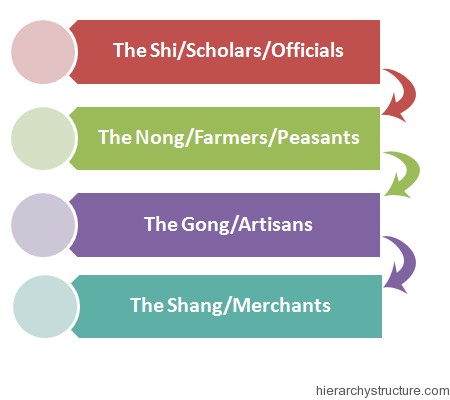Social structure hierarchies were prevalent in most of the parts of the world. China also practised a social hierarchical structure in its societies that were divided into classes. The social classes of Ancient China Hierarchy can beclassified into four major categories. These were shi, nong, gong and shang.
The shi were also called as scholars, nong as farmers, gong as artisans and shang as merchants. The Chinese social hierarchy was designed in order of importance of the particular classes for the society. The higher ranks exhibited more responsibilities and value towards the society and the lower ranks exhibited relatively less value towards the society. Let’s discuss all the four major social classes in details which includes following major levels:

- Shi/Scholars/Officials
- Nong/Farmers/Peasants
- Gong/Artisans
- Shang/Merchants
The Shi/Scholars/Officials
The shi held the highest status in the Chinese social hierarchy. They wore silk robes as an identification of their status. They had the rights to ride in chariots, carry weapons and command battles. They were well educated too. They served in various job roles such as advisors, clerks, overseers and scribes. They also served in various administrative services. They performed various civil functions. The people of this group gave examinations to get into various government positions. They entered into governments of various levels such as district, provincial and federal levels.
The Nong/Farmers/Peasants
Agriculture played a vital role in the rise of the China’s civilization. The food produced by the farmers or the Nongs sustained the whole society. Therefore, they were considered as the valuable members of the society. They held the second highest rank in the Chinese social hierarchy. They also provided services to the nobles. The most important fact associated with the Nongswas that they provided revenue to the country.
The Gong/Artisans
The Gong class consisted of Artisans and craftsman. They were higher in position than that of the merchants. They also had a significant role for the country. They worked in either the government sectors or the private sectors. Many artisans also worked on their independent businesses. They were involved in various types of jobs. They produced textiles, potteries and worked in various architectural works. They were valued because of their specific skills.
The Shang/Merchants
This class was the lowest in the Chinese social hierarchy because they didn’t produce anything and gained profit from other organizations. This particular social class comprised of shopkeepers, bankers, sellers and traders. They lived in towns and provided goods and services to the landowners. They were not allowed to carry weapons.The superior members of the Chinese hierarchy believed that the government officials must not be concerned with money. So, they didn’t allow the merchant class to opt for the government jobs.
The above four classes were strongly prevalent during the dynastic periods of China. With time, the classes also exhibited reformation in their structures. Over time, the merchant class earned more due to the advancement in the trade industry. The attitudes of people about the social classes also changed along the way.
